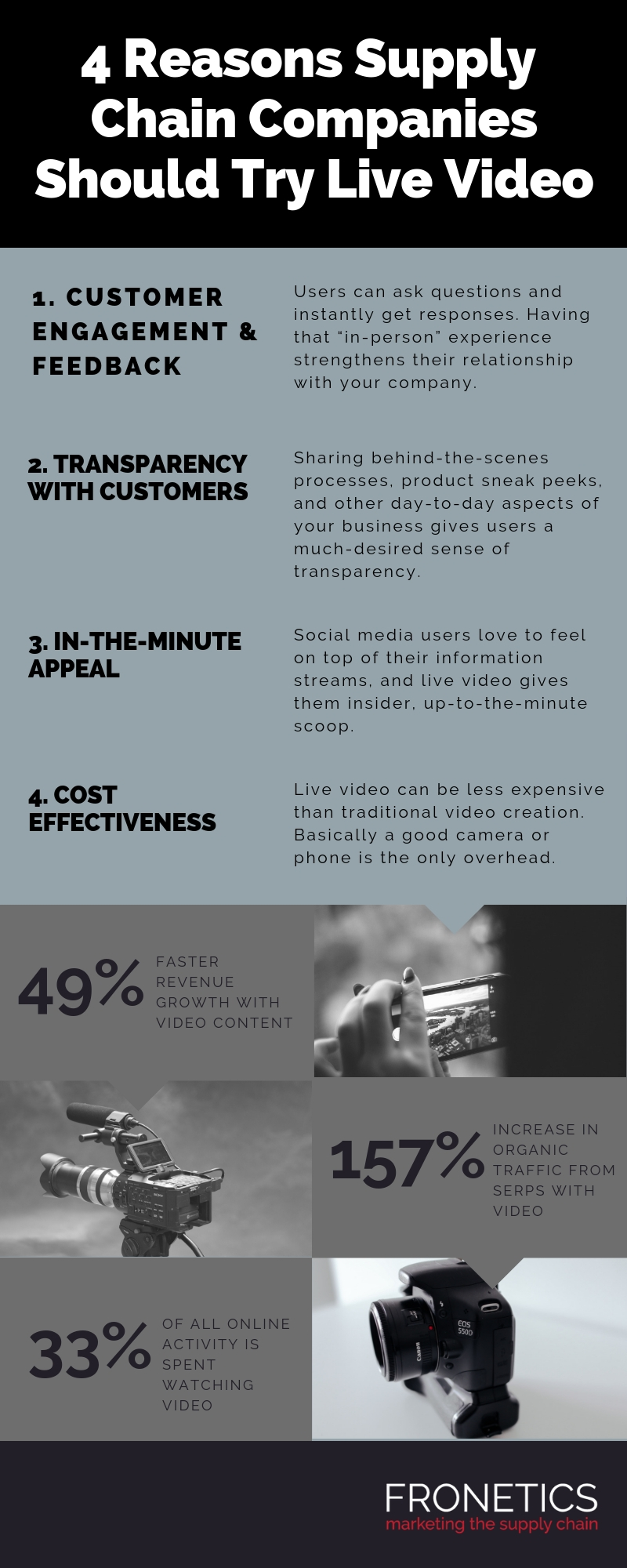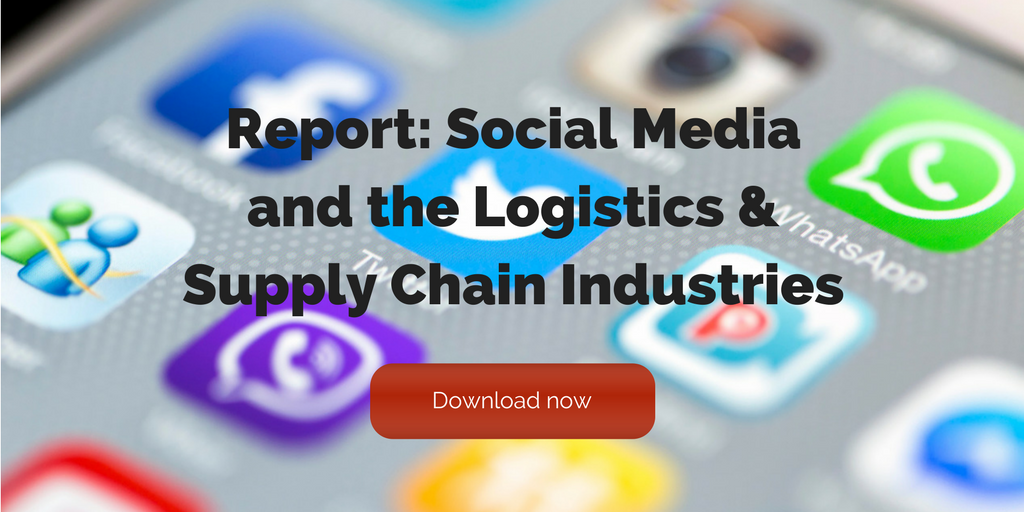
by Elizabeth Hines | Jan 16, 2019 | Blog, Content Marketing, Logistics, Marketing, Supply Chain
Updated February 4, 2025
Digital marketing for the supply chain has become necessary to position your company to not only be found online, but also to be researched and to be compared to your competition.
Highlights:
- Digital marketing uses your website, related social media, and other online industry channels to showcase your industry knowledge and experience.
- Thought leaders are the informed trusted sources in their field of expertise.
- Supply chain and logistics industries need content marketing to achieve confidence and relationship-building with buyers.
Today’s B2B buyers are researching, evaluating, and coming to conclusions about companies without a single contact with a team member or salesperson.
This kind of B2B buying landscape requires cutting edge marketing strategies to showcase nut-and-bolt industries that have survived without them for many years.
Digital marketing for the supply chain
Digital marketing for the supply chain uses your website, related social media, and other online industry channels to showcase your industry knowledge and experience (rather than trying to convince people of it with a marketing message).
With inbound digital marketing, you publish relevant, informative information to adds value to every stage of a potential customer’s buying journey.
It is the content that you publish that walks them through the initial stages of the sales process.
What should you publish? A good content marketing strategy is about understanding the questions and concerns that are particular to your customer base, and offering quality information and analysis that answers those needs.
Showcasing thought leadership through digital marketing
Discovering and meeting the needs of your customers that go beyond your products and services will catapult you in their minds as a knowledgeable, helpful “thought leader” in your industry.
Thought leaders are the informed trusted sources in their field of expertise. They have innovative ideas, can showcase their thinking, and can replicate their successes again and again.
Consider it: Your business has so much more to offer than its primary product or service. You have a team of people with a tremendous aggregate of experience, expertise, and perspectives.
Allowing your customers this sort of access to your team’s experience and knowledge provides them with tremendous value outside the sales funnel, which builds trust and cultivates lasting, fruitful relationships.
Why digital marketing?
In this B2B buying landscape, supply chain and logistics industries need content marketing to achieve a level of confidence and relationship-building with buyers that used to come from face-to-face meetings. Potential and current customers will view your company as a valuable resource for everything related to not only your products and services but to the industry as a whole.
No time to execute?
The downside? Content marketing requires significant time, labor, and resources, and it can take quite some time to start reaping benefits. Feeling overwhelmed and like you and your team can’t possibly add on more marketing? Outsourcing certain key marketing tasks allows insourcing your core competencies while delegating specialized tasks to external experts.
This post originally appeared on EBN Online.
Related posts:

by Jennifer Hart Yim | Jan 15, 2019 | Blog, Consumer Electronics, Content Marketing, Logistics, Manufacturing & Distribution, Marketing, Supply Chain
It’s time for consumers to stand up to tech giants and force them to procure raw materials, used in an ethical and sustainable manner, for smart devices.
Highlights:
- Smart devices have created a dependency on batteries.
- Blockchain is being considered to track cobalt from its source in the production of lithium ion batteries.
- The number one way to decrease reliance on batteries is to reduce overall consumption of energy from batteries.
Battery technology is hot these days, no pun intended. Consumers are demanding high performance and safety from batteries as energy storage devices. Smart device manufacturers are responding by producing batteries that are smaller, safer, and store more energy; this performance comes at a cost. Increasingly rare and advanced materials are required to produce a safer and more high-performance battery for your smart device.
Cobalt is one of the key raw materials required to support the green revolution. Too bad over half of the world’s cobalt supply comes from the war-torn Democratic Republic of the Congo, where they are known to use child and slave labor in the mining of cobalt.
No one cares, however. Device manufacturers are delivering a price point and value that the consumers are willing to pay for. Supply chain reform could briefly interrupt this harmony, and peoples’ relationships with their smart devices could be jeopardized. The sad truth is that device manufacturers have pulled the wool over our eyes for too long and we have now become dependent on these batteries.
There is a solution, however.
Consumers have to stand up to tech giants such as Apple and Samsung and force them to procure raw materials used in an ethical and sustainable manner. This is happening in the “Responsible Cobalt Initiative” where blockchain is being considered to track cobalt from its source in the production of lithium ion batteries.
The blockchain method relies on adequate and honest oversight at the very site where the cobalt is being mined from the Earth in locations such as the DRC. How will honest oversight be implemented in what is known to be one of the most war-torn and corrupt regions of the world? Why wouldn’t Congolese mine owners simply lie about labor practices? In this case, the supply chain reform also requires political and cultural reform. I can’t help but think about that time when the U.S. tried to cause political and cultural reform in Iraq…
The bigger and more disturbing picture is that society is on track for over-reliance on lithium-ion batteries as energy storage devices. The number of smart devices is skyrocketing. And if electric vehicles achieve widespread adoption someday, the amount of lithium-ion batteries and cobalt required to fuel that growth will be staggering.
This is just one reason why the energy future of our planet is so uncertain. Surely the population will continue to grow. Smart device numbers will keep rising exponentially. The planet is going to need more energy and more energy storage. Hopefully, an increasing amount of energy will come from renewable and carbon-neutral sources. In order to maximize the potential of renewable energy installations, we need vast amounts of energy storage. Putting all our eggs in the lithium-ion battery basket is a very bad idea by-in-large due to the shortcomings of the cobalt supply chain.
[bctt tweet=”In order to maximize the potential of renewable energy installations, we need vast amounts of energy storage. Putting all our eggs in the lithium-ion battery basket is a bad idea due to the shortcomings of the cobalt supply chain.” username=”Fronetics”]
It is important to note that the number one, most surefire way to decrease our reliance on batteries is to reduce overall consumption of energy from batteries. Simply put, if everyone were to spend half as much time on their cell phones, we would need half as many cell phone batteries. The phone would have to be charged half as often, and the battery would last twice as long, thus requiring half as many batteries over time. Maybe we would even start talking to each other once again.
In addition to reducing consumption, humankind must pursue radical technological advances in the field of energy storage. Power-to-gas and room-temperature-superconductors are two cutting-edge technologies that have the potential to revolutionize the way we store energy. Distributed generation, smart grids, and passive heating and cooling are some more conventional ways to reduce the energy storage burden placed on large-scale renewable generating facilities.
To make a long story short, the force of corporate greed and government corruption has overpowered the force of the consumers’ desires up until now. I am sure that the vast majority of smart device users, if asked, would be opposed to the use of child and slave labor in the mining of raw materials for their smart devices. I, for example, would be willing to pay more for a device that guarantees fair and ethical trade up and down the entire supply chain. We must never forget that we the consumers have the ultimate power. If we want Apple or Samsung to change their ways, we can easily do that. Get out and vote. Make your voice heard. Stand up to corporate greed and government corruption. Take a break from your cell phone and talk to the person next to you. I promise the world will be a better place.
This article was written by Peter Chivers, an MBA student at the Peter T. Paul College of Business and Economics at the University of New Hampshire. Pete is an engineer and MBA student with a passion for innovation and the outdoors. He spends his free time with his family hiking mountains, gardening, and building ice fishing contraptions.
Related posts:


by Fronetics | Jan 10, 2019 | Blog, Content Marketing, Marketing, Supply Chain
With the start of the new year, it’s time to take a breath and get ready for what’s next. Here are five trends in supply chain marketing to expect in 2019.
Highlights:
- People trust people, not ads.
- Knowing how your customers communicate is key.
- Personal connection is the key to success.
There are a lot of sales and marketing speakers already shouting out the trends for 2019. It’s a fast-paced world, and it can be tough to tune out the noise and maintain your identity in the constantly shifting marketing landscape.
The best way to navigate all the changes and trends is to plan ahead and be aware of what’s in the pipeline. Here are five supply chain marketing trends to be on the lookout for in 2019.
1) People trust people, not ads.
We know that traditional, outbound marketing is falling out of favor, making way for inbound techniques to take the lead. In fact, a Nielsen study from nearly four years ago found that the four most trusted sources of advertising were (1) people you know, (2) branded sites, (3) editorial sites, and (4) reviews.
[bctt tweet=”A Nielsen study from nearly four years ago found that the four most trusted sources of advertising were (1) people you know, (2) branded sites, (3) editorial sites, and (4) reviews.” username=”Fronetics”]
With ad blockers on the rise and this continued cultural shift towards inbound marketing, supply chain marketers need to tailor their efforts towards creating reliable, relevant content that will be of value to their customers.
2) Creativity is the wave of the future
We’ve written before about the increasing need for creative thinking in the supply chain. It’s no different when it comes to marketing the supply chain. The age of conformity is over (if it ever really existed in the first place). With so many players on the field, the ones who will really stand out in the coming years are those who think outside the box.
While we can’t tell you how to be creative, remember that content marketing, at its core, is about telling stories. Take a step back and think about your brand, its story, and what it means to your audience — then get ready to brainstorm!
3) Successful businesses will focus on breaking down internal divisions.
We’re always amazed by the persistent fear that content marketing is somehow the enemy of sales teams. In fact, we’ve written frequently about the symbiotic relationship between marketing and sales, and the need for alignment between the two departments.
Increasingly, supply chain companies need synergy between sales and marketing to be successful. In a recent article in Forbes, Calendar co-founder and President John Hall writes, “companies that put up barriers between departments will fail in the long run.” We agree. Hall goes on to point out that “great content can fuel other parts of the company, resulting in better talent, lower costs, and improved relationships with investors.”
4) Knowing how your customers communicate is key.
It’s easy to forget how quickly communication has changed over the past several decades. While life before cell phones is a dim memory, it’s important to remember that the ways in which we communicate with each other as individuals and as businesses continue to evolve.
For content marketing efforts to be successful, supply chain companies need to be keenly aware of how their target buyers are interacting, and they need to be ready to meet their buyers where they are. Keep a finger on the pulse through social media, and continue to evaluate and refine how well your content is reaching and resonating with your target audience.
5) People haven’t really changed that much.
Ok, so we’ve been telling you about all of the seismic cultural shifts brought about by technology, and all of the ways that marketing has changed over the past decade, and now this? Well, at the end of the day, people are still people, and they value helpfulness, authenticity, and relationships.
Luckily, that’s what good content marketing is all about. As technology and automation continue to progress, it’s crucial to remember the point of it all: personal connections and communication of trustworthy, valuable information.
Related posts:


by Fronetics | Jan 8, 2019 | Blog, Content Marketing, Logistics, Marketing, Strategy, Supply Chain
Before you make your marketing resolutions for this year, take a moment to look at last year’s digital content marketing successes and failures.
As the new year begins, take the opportunity to look at past marketing choices, see what worked and what didn’t, and shape goals for the future. The year ahead is a blank canvas, but evaluating past successes and missteps is key to making sure the big picture works.
Writing for Forbes Communication Council, Senior Digital Marketing Manager at Caring People Inc. Karina Tama-Rutigliano offers these four tips for successfully moving forward with digital marketing.
1) Don’t go anywhere without clear, specific goals — and a plan for measuring results.
Assuming you’ve been tracking useful metrics along the way, the end of the year means you’re armed with a fresh crop of data. Take time to study and evaluate your data, and use it to develop incremental goals, as well as projections for next year. If you haven’t already, now is a good time to implement a documentation strategy, like our Monthly Marketing Report Template.
Furthermore, take a moment to consider how the metrics you’re currently tracking are serving you. Is your data giving you the insights you need? Are you left with questions about where your efforts are successful, or where another approach is needed? The beginning of the year is a good time to tweak your plan for tracking and measuring the results of your digital marketing efforts.
2) Don’t forget the “social” in social media.
[bctt tweet=”Social media platforms are viable places to engage with your customers,” writes Tama-Rutigliano. This means encouraging interaction with your posts, replying to comments, and engaging with posts from your community.” username=”Fronetics”]
You’re so busy creating and curating content to be fresh, relevant, and engaging for your social media audience, you forget that one crucial part of social media marketing: the social. “Social media platforms are viable places to engage with your customers,” writes Tama-Rutigliano. This means encouraging interaction with your posts, replying to comments, and engaging with posts from your community — be part of the conversation, and build relationships.
3) Don’t put all your eggs in one basket.
With so many options for digital marketing, all of them full of possibilities, it can be tempting to choose one or two and put all your dollars and efforts there. But a successful digital content marketing strategy is robust and well-rounded. Use your year-end data to evaluate where your efforts are thriving, and where you need to devote some cash and ideas.
4) Don’t post without a purpose.
We’ve all felt the push to create content, just for the sake of getting something new up on the blog or social media platforms. But content without a clear purpose in mind is never going to get you the best results.
It’s easy to get cynical, and think that content creation is just about feeding the search engine beast. But the heart and soul of content marketing is about sharing your knowledge and expertise with your customer-base, building trust, and creating lasting relationships.
Related posts:


by Fronetics | Jan 3, 2019 | Blog, Content Marketing, Logistics, Marketing, Social Media, Supply Chain
Live video streaming helps businesses promote transparency, good communication, and relatability.
Live video is one the biggest trends in social media marketing right now. According to the 2018 Social Media Marketing Industry Report, 77 percent of marketers plan to increase their use of video this year and 68 percent want to start using live video.
[bctt tweet=”77 percent of marketers plan to increase their use of video this year and 68 percent want to start using live video.” username=”Fronetics”]
It’s really no surprise video has gained such traction. Platforms like YouTube made the transition from watching TV in your home to watching videos on your phone seamless. And live streaming fits in with today’s emphasis on corporate transparency and putting a real, human face to business social media accounts. It allows brands to drop their corporate façade and connect to users in a more human way.
Before you ask, let me say it again: Yes, video can work for the supply chain.
Starbucks and live streaming
You don’t have to take our word for it. Look at the success of Starbucks. Back in 2016 the coffee giant tried their first live feed at an event in Queens, New York, to promote National Voter Registration Day. The live video showcased Starbuck’s involvement in the community and their dedication to social events. It was a huge success. The streaming content allowed viewers who wouldn’t otherwise be able to make the event learn about the cause and its importance.
Still not convinced? Check out this infographic with 4 reasons why the supply chain needs to try live video.
Infographic: 4 reasons the supply chain needs live video

(Made with Canva)
Live streaming platforms
Want to dive into live video, but don’t know where to start? Here’s a few of the most popular platforms.
- Facebook Live: Facebook Live lets you broadcast in real time for up to 90 minutes per session. Users who have recently engaged (or who frequently engage) with your page will receive a notification that you are streaming live, and they can go to your page to view the video. Viewers can comment and react during the course of your broadcast, allowing you to read their remarks and respond immediately.
- Periscope: Twitter-owned and run, Periscope is a standalone platform but integrates seamlessly with Twitter. It has more than 10 million users, more than two million of whom log in daily. The service lets users live stream from their mobile devices and push out those streams on Twitter.
- YouTube Live: YouTube Live enables YouTube to utilize its expansive creator and advertising network to generate even more video to be hosted and monetized. YouTube makes it incredibly easy to aim, shoot and post live video.
Related posts:











